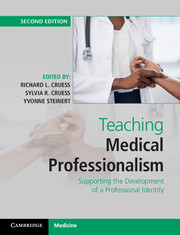Book contents
- Frontmatter
- Contents
- List of contributors
- Foreword
- Introduction
- Part I What is to be taught and learned
- Part II Theory
- Part III Principles
- Part IV Case studies in promoting professionalism and professional identity formation across the continuum
- 15 The evolution of an undergraduate medical program on professionalism and identity formation
- 16 Developing and implementing an undergraduate curriculum
- 17 Supporting professionalism and professional identity formation at the postgraduate level
- 18 Changing the educational environment to better support professionalism and professional identity formation
- Part V The future
- Index
- References
15 - The evolution of an undergraduate medical program on professionalism and identity formation
from Part IV - Case studies in promoting professionalism and professional identity formation across the continuum
Published online by Cambridge University Press: 05 April 2016
- Frontmatter
- Contents
- List of contributors
- Foreword
- Introduction
- Part I What is to be taught and learned
- Part II Theory
- Part III Principles
- Part IV Case studies in promoting professionalism and professional identity formation across the continuum
- 15 The evolution of an undergraduate medical program on professionalism and identity formation
- 16 Developing and implementing an undergraduate curriculum
- 17 Supporting professionalism and professional identity formation at the postgraduate level
- 18 Changing the educational environment to better support professionalism and professional identity formation
- Part V The future
- Index
- References
Summary
Sow an act, and you reap a habit. Sow a habit and you reap a character. Sow a character, and you reap a destiny.
Charles Reade
Introduction
“How can I do that and still be me?” Reflections of this nature by medical students are often found in the literature.1 The belief that medical education has the potential to form, transform, and perhaps even deform a person's core values or sense of self is commonly assumed by learners and teachers alike. The process has been explicated using various concepts, most notably medical character,2 ethical comportment,3 moral epistemology,4 humanism in medicine,5 and professionalism.6 More recently, particularly in North America, discussions on the topic have taken a turn toward the conceptual framework of identity.
The concepts of identity and “self-hood” are not new to many academic disciplines, including philosophy, psychology, and anthropology. Identity also has an honorable tradition in medical education. For example, in a research program that culminated in the influential 1957 publication, The Student Physician, sociologist Robert Merton and coauthors incorporated psychological perspectives on identity.8 Of late, however, identity seems to have acquired a privileged status as an analytical tool in understanding the phenomenon of “becoming a doctor.” A series of critical inquiries into professional education, funded by the Carnegie Foundation for the Advancement of Teaching, has recently been completed. It has identified the signature pedagogies of various professions and has suggested a clear direction for the teaching of professionalism in the twenty-first century. One of its primary conclusions is that students undergo personal transformations during their educational experiences. The study on educating the clergy focused on “pedagogies of formation.”9 The one that examined nursing practices referred to the teaching of “being, knowing, and doing.”10 The authors of the book on medical education discussed “identity formation,” by which was meant the transmission of professional values and commitments.11 That series has reinforced the conviction of many that medical education should be reframed so that it actively supports professional identity formation.
This chapter is focused on the Physicianship Program at McGill University's Faculty of Medicine. It describes the teaching of professionalism from a perspective that is tightly coupled to the development of attributes considered necessary for the good doctor.
- Type
- Chapter
- Information
- Teaching Medical ProfessionalismSupporting the Development of a Professional Identity, pp. 217 - 230Publisher: Cambridge University PressPrint publication year: 2016
References
- 3
- Cited by



